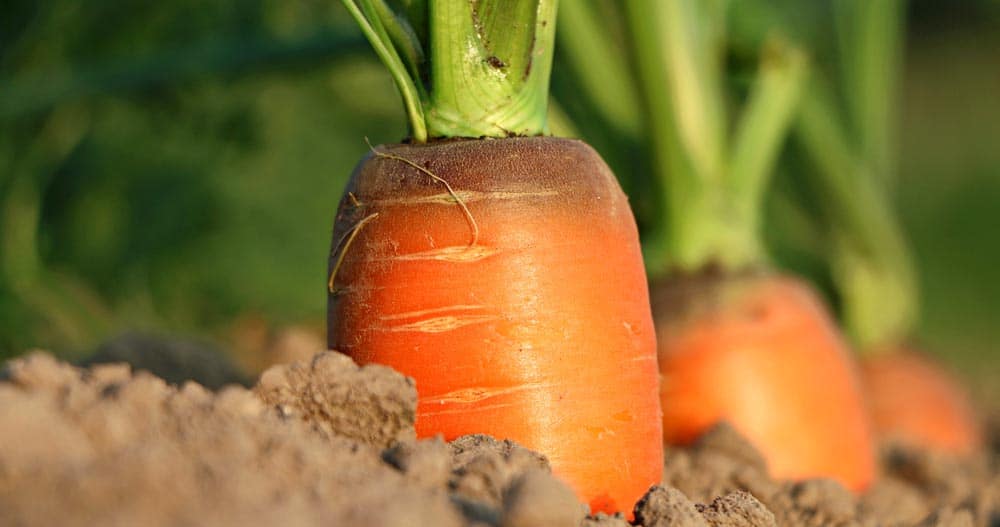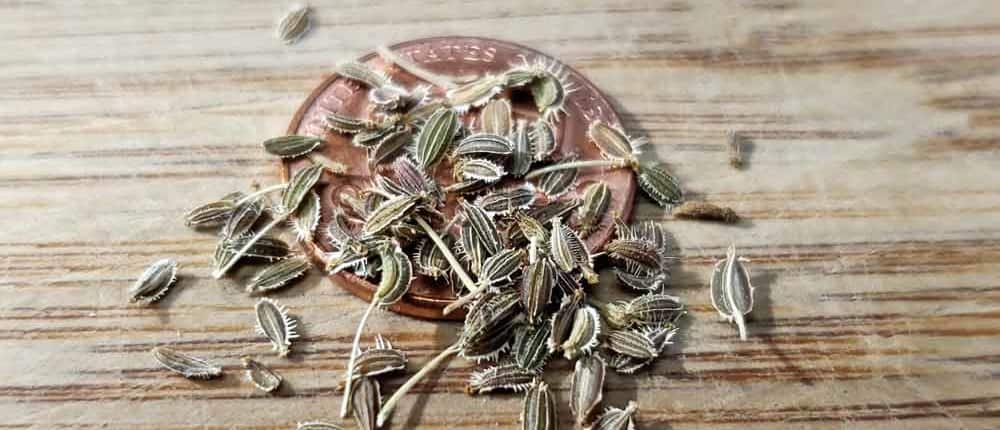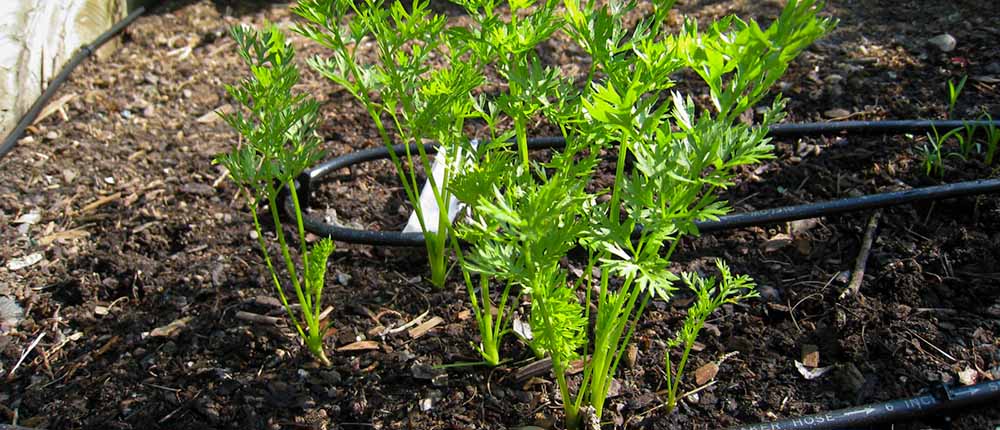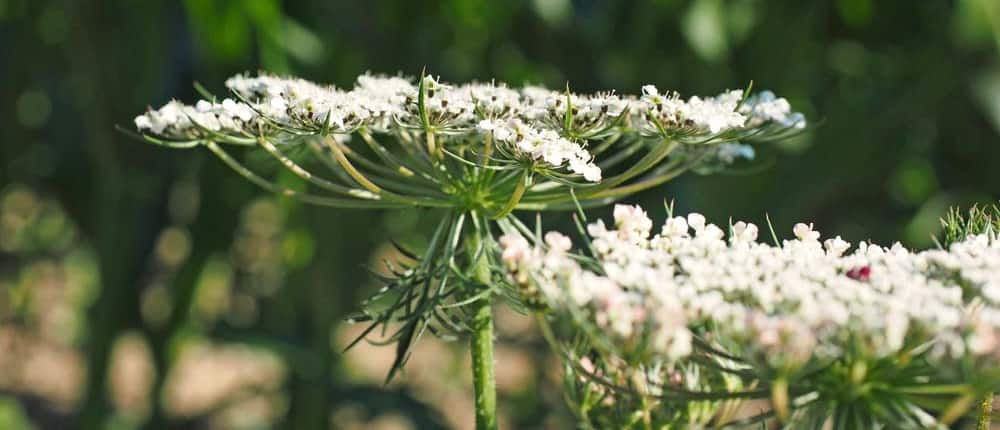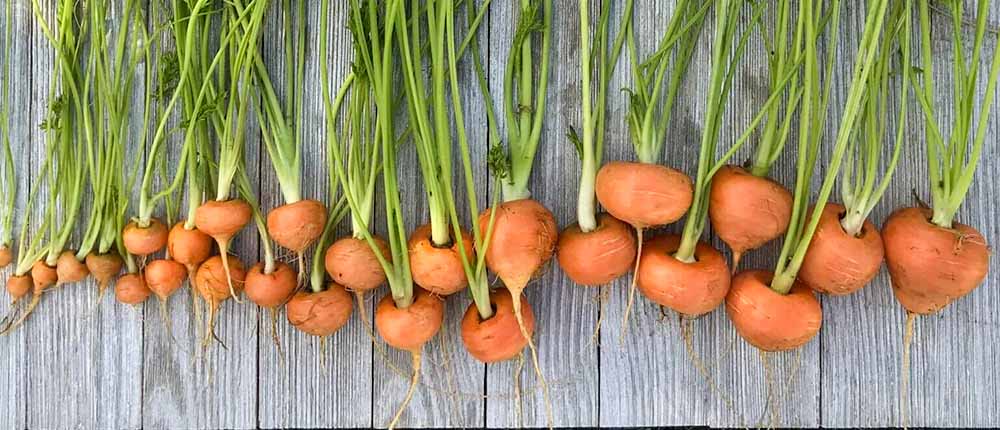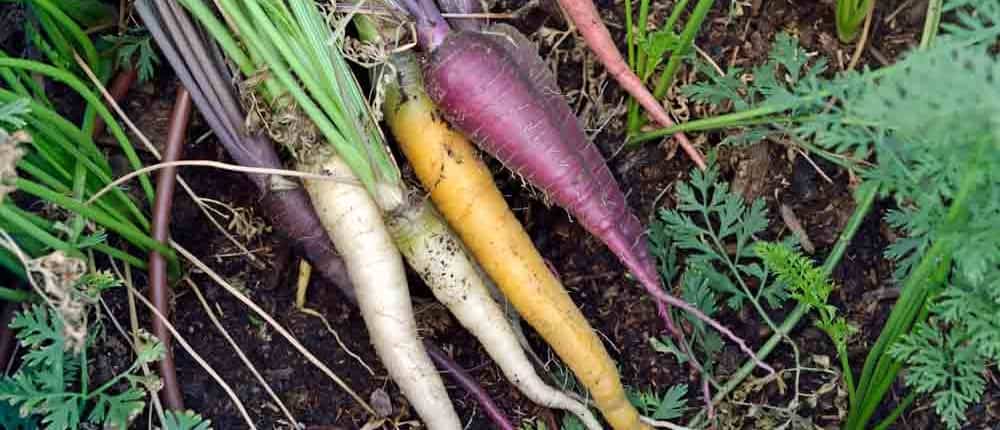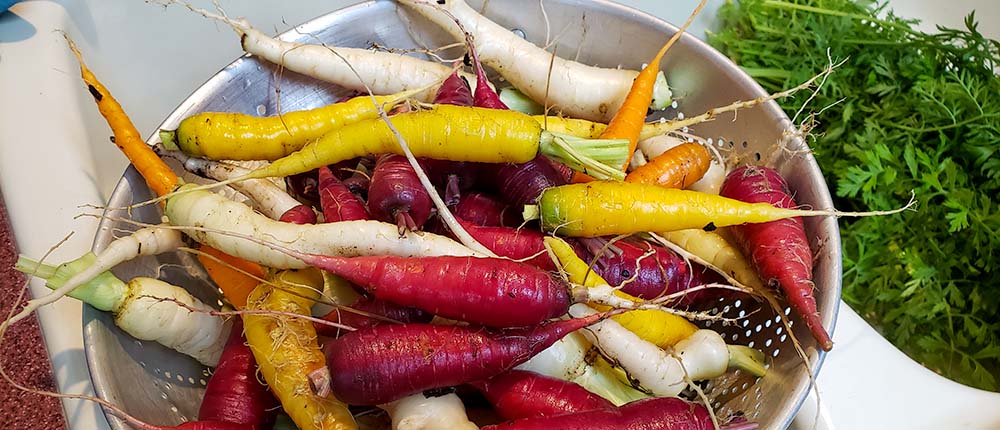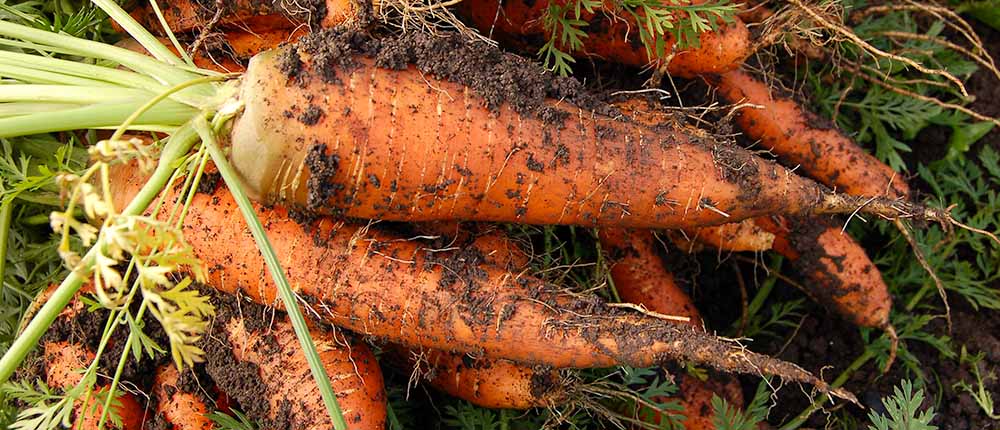Growing Delicious Carrots
from Seed to Harvest
The best carrots etch themselves in our memory from the first bite – crisp and crunchy with a bold, sweet, yet complex flavor. They are a cornerstone of the home garden, yet that perfect homegrown carrot can be elusive if you don’t understand what it needs. Luckily, carrot varieties come in all shapes and sizes for different gardening conditions – long and tapered, short and stubby, or tiny fingerlike. Different lengths are suited to different soils and lengths of season.
Carrots are a root crop that can thrive in almost any garden, from a container on the porch or balcony to raised beds and traditional in-ground gardens.
They are perfect for introducing children to gardening, as the excitement of planting, caring for, and finally pulling and tasting that first home-grown carrot will become a treasured memory. Because they mature relatively quickly, they are perfect for succession sowing and spring and fall gardens, keeping a steady supply of fresh, delicious treats coming.
Partially cleaned carrot seeds.
History
Evidence suggests that the earliest carrots – Daucus carota – were cultivated for their aromatic leaves and seeds used for medicinal and aromatic purposes. Carrot seeds have been found in Switzerland and southern Germany, dating from 2000-3000 BC. The plant is depicted and described in the 6th-century AD Eastern Roman Juliana Anicia Codex, a copy of the Greek physician Dioscorides’ 1st-century pharmacopeia of herbs and medicines, De Materia Medica. The text states that “the root can be cooked and eaten,” suggesting that while the leaves and seeds were the primary focus, the edible part of the root was not entirely unknown.
Carrots traveled to Europe via trade routes, arriving in Spain with the Moors in the 8th century. By the 10th century, various carrot cultivars were grown throughout Europe, often prized for their purple or yellow roots. Around this time, the modern carrot as we know it emerged in Afghanistan. By the 11th century, scholars like Simeon Seth and the 12th-century Arab-Andalusian agriculturist Ibn al-‘Awwam documented red and yellow carrots.
Cultivated carrots appeared in China in the 12th century and in Japan in the 16th or 17th century. However, it wasn’t until the 17th century in the Netherlands that the familiar orange carrot we know and love today was developed. Dutch growers selectively bred carrots for their orange color, which is associated with the House of Orange, the Dutch royal family. This new, brightly colored variety quickly gained popularity and eventually spread worldwide.
European colonization expanded the carrots range, introducing them to the Americas and other parts of the world. Today, carrots are cultivated globally and enjoyed for their sweet flavor, nutritional value, and versatility in the kitchen.
Carrot seedlings growing with a drip system.
Carrot Myths Busted
The Truth Behind Common Misconceptions
Myth 1: “Carrots are difficult to grow.” This common misconception couldn’t be further from the truth! Carrots are relatively low-maintenance compared to many other vegetables that require extensive staking, pruning, or pest control.
The key to success lies in proper soil preparation.
Carrots need loose, well-draining soil that allows their roots to grow, no matter their length. Dense, compacted, heavy soil leads to stunted, misshapen carrots, which might have fueled this myth. But knowing what they need, and with a little effort to loosen and amend your soil, you’ll be surprised at how effortlessly carrots thrive. Even novice gardeners can enjoy a bountiful harvest with just a little knowledge and care.
Myth 2: “All carrots are orange.” While the familiar orange variety is most commonly seen, heirloom carrots come in a wide range of colors – deep purples with hints of spice, bright yellows bursting with sweet, earthy flavor, creamy whites with delicate sweetness, and even rich reds with complex, nuanced tastes.
Growing a mix of these colorful varieties creates a visually stunning harvest.
Myth 3: “You need a huge garden to grow carrots.” Carrots are remarkably adaptable and can flourish in a variety of spaces. Whether you have a sprawling backyard garden or a cozy balcony, there’s a carrot-growing solution for you. Raised beds and containers are perfect for cultivating carrots, and many compact varieties are specifically bred for smaller spaces.
Even containers as shallow as 6 inches can grow shorter or round varieties.
Savor the Flavor
The Heirloom Carrot Difference
Commercial carrots are usually bred for uniformity, high yields, and their ability to withstand long shipping and storage. Consequently, they typically offer barely a hint of sweetness, a far cry from the taste of a home-grown carrot.
Heirloom carrots, however, are truly remarkable.
Each bite has flavorful layers of rich sweetness, mineral undertones, or spicy notes. This remarkable depth of flavor is the result of several factors. Home-grown carrots develop slowly, allowing sugars and complex flavor compounds to mature fully, resulting in a far more nuanced and satisfying taste.
Carrot flowers in bloom.
Site and Soil Needs
For Growing Delicious Carrots
At their heart, carrots are a cool-season crop, but they can grow well in warmer weather with some understanding of their needs. Remember, these tasty roots originated in the high mountainous regions and were initially bred in the cooler climates of Europe, and they haven’t forgotten that!
Full sun is preferred, with afternoon shade in areas with warmer summers, and the soil needs to be well-drained. The ideal soil is a sandy loam that is deep and loose. In other words, carrots really like perfect soil! If your soil has stones, roots, clay or hard lumps, etc., the roots will bend, fork, twist, or even completely stop.
A good rule of thumb is to loosen the soil to twice the depth of the mature carrot variety you’re planting.
Old gardeners say the soil should be loose enough to plunge your outstretched hand past the wrist with little effort. For most full-size carrots, this means loosening the soil to a depth of 12-15 inches.
Here’s how to create the ideal soil environment for your carrots:
- Loosen the soil: Use a garden or broad fork to lift and aerate the soil gently. Avoid inverting the layers, as this can disrupt beneficial soil microbes.
- Remove obstacles: Carefully pick out any rocks, roots, or debris interfering with carrot growth.
- Amend with organic matter: Mix generous amounts of compost or well-aged manure into the soil. These amendments work wonders, improving soil structure, drainage, fertility, and moisture retention. They also introduce beneficial microbes that support plant health and nutrient uptake. Aim to mix in a 2-4 inch layer of compost or manure throughout the planting area.
- Level and smooth: Rake the soil surface to create a level seedbed. This ensures even germination and prevents seeds from washing away during watering.
By taking your time and properly preparing your soil, you’re laying the groundwork for a bountiful carrot harvest.
Planting buckwheat as a cover crop 30-45 days before your carrot crop will do wonders to improve your soil. It will free up locked nutrients, especially phosphorus and potassium, choke out weeds, and loosen topsoil. Carrots need good, consistent supplies of phosphorus and potassium with less nitrogen for the best growth and flavor. Excess nitrogen can stunt the roots while the tops grow excessively.
Adding generous amounts of aged organic matter, such as rich compost, acts as a sponge, retaining moisture longer and releasing it over time, adding nutrients. Freshly applied or dug-in compost can cause the roots to fork and send out small side roots, so amend your carrot bed in the fall before planting or use a 30-day cover crop, as discussed above.
Parisian ball carrots
Choosing the Right Variety
For Your Garden and Soil Conditions
If your soil isn’t perfect, you can still grow a successful carrot crop by selecting the appropriate type and length of carrot for your soil. Carrots are categorized by shape, including round, stubby, triangular, or tapered varieties.
The first step is considering your climate, growing season, and soil type.
- Temperate areas that don’t get hot in the summer are the easiest climates to grow in. You can choose any carrot type that catches your fancy or tastebuds.
- Areas with long, cold winters are a little more challenging to grow in, as you’ll need to plan for a mid-spring to late summer or early fall growing season. Fast-maturing varieties are always a good choice, but heavily mulching some cold-hardy types in early fall for later harvest is another option.
- The most challenging climate is one with hot, long summers. Choose fast-maturing varieties, plant under afternoon shade, or use shade cloth to protect your carrots from the scorching sun. A thick layer of mulch also helps keep the soil cool and moist, and a timer-based drip system, adjusted to even out soil moisture levels during the day, can be key to bountiful crops, especially in the arid Southwest.
Mulching the surface to a couple of inches deep after planting insulates the soil, keeping it cooler while helping to preserve soil moisture, especially in warmer climates.
Consistent soil moisture is an important but often overlooked factor in growing excellent carrots.
Kaleidoscope baby carrots.
Planting Tips
As with most root crops, carrot seed can be directly sown into your garden as early as three to four weeks before your last expected frost. If your soil is not already very moist, water it well before sowing seeds to speed up germination.
For a continuous harvest, succession plant seeds at about 2-week intervals starting in early spring through early fall or until a month before your first expected frost.
Try to plant carrot seeds about 1 to 1 ½ inches apart, which can be difficult to do by hand because of the seed’s tiny size. After placing them on top of the soil, lightly cover them with loose, pulverized soil or organic matter, as the seedlings won’t come up through a hard crust. Water again after sowing with a fine spray, then cover with a layer of straw mulch to keep the soil moist.
One alternative to carefully hand-spacing the seeds is to sow them together with a radish mix, planting them by slowly drizzling them through your fingers along the row. The radish seedlings emerge first and shade the slower-growing carrots while marking the rows and breaking any soil crust. You’ll harvest the radishes in 3 weeks, giving the carrots room to mature unhindered while keeping the soil moist.
Thin carrot seedlings in two stages, if needed. The first thinning is when the seedling is 1–2 inches tall. Remove any seedlings closer than ½ inches apart by clipping the tops at soil level, avoiding disturbing the other roots. Once the tops are 6 inches tall, thin a second time by pulling the baby carrots closer than 1 ½ inches apart, enjoying them as snacks or in an early salad.
A rainbow of carrot colors.
Watering Your Carrots
The Goldilocks Approach
Like Goldilocks, carrots prefer their water “just right” – not too much or too little. They are thirsty, but they also dislike having their feet constantly wet. Consistent moisture is essential for healthy root development, but overwatering can hurt their growth. Too much water deprives roots of oxygen, leading to root rot and inviting fungal diseases. So, how do you strike the perfect balance?
The key is to check soil moisture regularly.
A simple way to do this is to stick your finger about an inch deep into the soil near the base of the plants. If it feels dry, it’s time to water. If it feels damp, hold off for another day or two. The watering frequency will depend on your climate, soil type, and the stage of carrot growth.
Shallow watering is best for round or smaller carrots less than 4 inches long, while deeper watering encourages longer carrots to reach for the moisture in the soil.
Companion Planting
One of the first things many beginning gardeners learn is that carrots love tomatoes, thanks to Louise Riotte and her book of the same name, first published in 1975. Companion planting herbs will attract beneficial insects and deter pests.
Carrots are beneficial to and get along well with many different vegetables and herbs, such as broad beans, calendula, chives, cucumbers, flax, leeks, lettuce, marigolds, peas, pennyroyal, peppers, radishes, rosemary, sage, salsify, and tomatoes.
Only a few antagonistic plants exist, such as dill, parsley, fennel, and potatoes.
Classic Red Cored Chantenay carrots.
Harvest Tips
Knowing when to start harvesting carrots is all about touch and timing! The ideal harvest time varies depending on the variety you’re growing, but there are some general signs to look for.
Begin to harvest carrots when their shoulders (the top part of the carrot root) reach about ¾ to 1 inch in diameter. You might see the shoulders peeking out of the soil. However, don’t rely on size alone. The color of the carrot tops (the greens) is also a good indicator of ripeness. As carrots mature, their tops often change from bright green to a darker, richer color. For example, the tops of purple carrots may develop reddish or purplish tones when ready for harvest.
To confirm ripeness, perform the “finger test.”
Gently press your finger on the top of the root near the soil line. If it feels firm and slightly gives under pressure, your carrot is likely ready to harvest. If it feels soft or spongy, give it more time to develop.
Remember, not all carrots in a row will mature at the same rate. Selectively harvest the largest carrots while allowing smaller ones to continue growing. This ensures you get the most out of your harvest and extends your enjoyment of fresh, homegrown carrots.
When your carrots are ready, harvest them by grasping the carrot top and giving it a good twist to break off the fine hairs, making it easier to pull. When you have finished harvesting, cut the tops off immediately before storing. Carrot tops look pretty at the farmer’s market but continue to draw nutrients and moisture from the root, leaving them limp and flavorless.
Carrots can keep a long time in the crisper drawer in your refrigerator, or even well-mulched in the ground over the winter if you don’t get a prolonged hard freeze. Experienced gardeners report that overwintering in the garden sweetens the carrot and gives it a richer, deeper flavor as it gathers nutrients.
Carrots are an essential and beloved vegetable in any garden. With the right expertise and careful planning, you can cultivate some of the most delectable and flavorful roots you’ve ever tasted!

